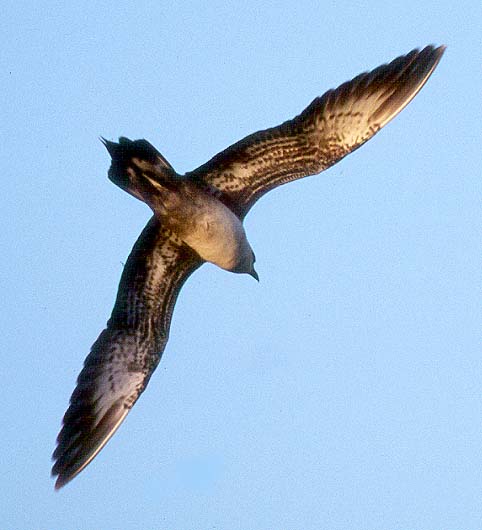
All rights reserved.
I was overwhelmed by the expertise evident in the comments on this bird. I showed this bird to the Identification Panel at the WFO meeting in Reno last December where Steve Howell thought it might be a second calendar year Long-tailed. Originally I assumed that it was Parasitic because of the pointed rectrix tips in what I assumed was still largely juvenal plumage. I had forgotten that jaegers are like terns in their tail molt, replacing rectrices twice annually instead of only once as in most other birds.
The bird was in an area where Long-tailed Jaegers were nesting and where no Parasitic Jaegers were seen. I showed this photo to Chris Corben who also thought it was probably a Long-tailed. Chris commented that the shape of the individual rectrices was more typical of Long-tailed, being broader a the base and tapering at the tip. He felt Parasitic would show less evident tapering.
I received the following email from Klaus Malling Olsen who is coauthor of the definitive "Skuas and Jaegers - A Guide to the Skuas and Jaegers of the World."
I have seen the photos of the strange-looking skua. Jizz of of no really value on this photo. However, the white bases to the new primaries AND primary coverts seems very odd for Long-tailed, but fits perfectly for Arctic Skua (Stercorarius parasiticus). In Long-tailed, all older generations (apart from juvenile) primaries have dark undersurfaces, and the primary coverts are evenly barred, not paler-based as shown on the photo. Argumently, I have one photo of a juvenile Long-tailed showing paler bases to primary coverts (creating a pale double-marking" at the wing-bend together with pale primary base - a feature often claimed as pro Pomarine character (somewhat true), but often seen in Arctic. Based on this sole character, underlining the fact that immature skuas shows much varying plumage otherwise and rarely are identifiable on plumage characters alone, my best guess is Arctic.
With expert opinion well divided and uncertain, I feel it unwise to put a name to this bird at this time, pending further research.
To view public comments or join the fray by adding your opinion, click here. Have fun!
 |
Photo © Peter LaTourrette All rights reserved. |